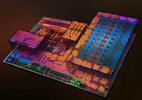AMD Radeon RX Vega 7 vs NVIDIA GeForce GT 730M
AMD Radeon RX Vega 7
► remove from comparison
The AMD Radeon RX Vega 7 is an integrated GPU for notebooks. It is used in the Ryzen 4000 and Ryzen 5000 mobile APUs. The GPU is based on the Vega architecture (5th generation GCN) and has 7 CUs (= 448 shaders) clocked at up to 1,800 MHz. The iGPU's performance depends on the TDP of an APU (15, 35, 45 W or cTDP), the clocks, the cooling, and the memory configuration). The GPU should benefit from fast dual-channel DDR4-3200 RAM (contrary to DDR4-2133 single-channel, which is also possible).
The Vega architecture offers some improvements over the Polaris generation and now supports DirectX 12 Feature Level 12_1. More information is available in our dedicated article about the Raven Ridge architecture.
The performance should be slightly lower than the older RX Vega 8 GPU (1 CU more, but lower clock speed). That means, only some demanding games of 2019 will run in lowest detail settings. Less demanding games like Fifa 20 or Dirt Rally 2.0 should run in higher settings and 1920 x 1080.
Thanks to the 7 nm process and clever power-saving features, the power consumption is comparatively low (according to AMD), so the iGPU won't look out of place in a slimmer, lighter laptop.
NVIDIA GeForce GT 730M
► remove from comparison
The NVIDIA GeForce GT 730M is a DirectX 11 graphics card of the middle class. It is based on the Kepler architecture and manufactured by TSMC in a 28-nanometer process. In addition to an older version with the GK107 chip (384 shader, 128 bit memory), there also exist models with the new GK208 (384 shader, 64 bit memory). Both versions use DDR3 memory.
Architecture
Both GK107 and GK208 are based on the Kepler architecture and offer two shader blocks, called SMX, each with 192 shaders for a total of 384 shader cores. The shaders are clocked at the same speed as the rest of the chip. Although more shader cores are available in the Kepler architecture as compared to the Fermi design, the Kepler shaders are much more efficient. However, due to the missing hot clock of the shader domain, two shaders of a Kepler chip are as fast as one shader of a Fermi chip even though Fermi shaders are clocked at twice the speed.
PCIe 3.0 is now supported by the mobile Kepler series and an optional Turbo mode can automatically overclock the Nvidia card by a theoretical 15 percent if the laptop cooling system allows it. This feature is available on any notebook with a graphics card of the 700M series.
Performance
The gaming performance of the GK107 version is on the same level or slightly above an average GT 645M, or about 10 - 15 percent below the GT 650M. Therefore, demanding games (as of 2013) like Battlefield 3, Bioshock Infinite, or Tomb Raider are playable in 1366x768 resolution and medium settings. Less demanding games like Diablo III can be played fluently with maxed out settings at full HD resolution settings. The GK208 version, however, performs significantly worse and is sometimes even below the GT 640M. Still, the performance depends on the core clock and the GPU Boost 2.0. Detailed benchmarks can be found further down on this page.
Features
The improved feature set now includes support for up to 4 active displays. Furthermore, high resolution monitors of up to 3840x2160 pixels can now be connected using DisplayPort 1.2 or HDMI 1.4a if available. HD-Audio codecs, such as Dolby TrueHD and DTS-HD, can be transmitted via bitstream mode through the HDMI port. However, as most laptops will feature Optimus, the integrated GPU will likely have direct control over the display ports and may limit the feature set available by the Nvidia Kepler cards.
The 5th generation PureVideo HD video processor (VP5) is also integrated in the GK107 core and offers hardware decoding of HD videos. Common codecs such as MPEG-1/2, MPEG-4 ASP, H.264 and VC1/WMV9 are fully supported up to 4K resolutions while VC1 and MPEG-4 are supported up to 1080p. Two streams can be decoded in parallel for features such as Picture-in-Picture. Another novelty is the inclusion of a dedicated video encoding engine similar to Intel QuickSync that can be accessed via the NVENCI API.
The power consumption of the GeForce GT 730M should be similar to the GT 640M or possibly slightly less. As a result, the Nvidia GPU is best suited for multimedia notebooks 14-inches in size or greater.
| AMD Radeon RX Vega 7 | NVIDIA GeForce GT 730M | ||||||||||||||||||||||||||||||||||||||||
| GeForce GT 700M Series |
|
| |||||||||||||||||||||||||||||||||||||||
| Codename | Vega Raven Ridge | ||||||||||||||||||||||||||||||||||||||||
| Architecture | Vega | Kepler | |||||||||||||||||||||||||||||||||||||||
| Pipelines | 448 - unified | 384 - unified | |||||||||||||||||||||||||||||||||||||||
| Core Speed | 1800 (Boost) MHz | 725 MHz | |||||||||||||||||||||||||||||||||||||||
| Shared Memory | no | no | |||||||||||||||||||||||||||||||||||||||
| API | DirectX 12_1 | DirectX 11, Shader 5.0 | |||||||||||||||||||||||||||||||||||||||
| Power Consumption | 15 Watt | ||||||||||||||||||||||||||||||||||||||||
| technology | 7 nm | 28 nm | |||||||||||||||||||||||||||||||||||||||
| Features | Tiled Rasterization, Shared Memory (up to Dual-Channel DDR4-2400) | Optimus, PhysX, Verde Drivers, CUDA, 3D Vision, 3DTV Play | |||||||||||||||||||||||||||||||||||||||
| Date of Announcement | 07.01.2020 | 01.01.2013 | |||||||||||||||||||||||||||||||||||||||
| Memory Speed | 1800 - 2000 MHz | ||||||||||||||||||||||||||||||||||||||||
| Memory Bus Width | 64/128 Bit | ||||||||||||||||||||||||||||||||||||||||
| Memory Type | DDR3 | ||||||||||||||||||||||||||||||||||||||||
| Max. Amount of Memory | 4 GB | ||||||||||||||||||||||||||||||||||||||||
| Notebook Size | medium sized |
| |||||||||||||||||||||||||
Benchmarks
3DM Vant. Perf. total + AMD Radeon RX Vega 7
specvp11 snx-01 + NVIDIA GeForce GT 730M
specvp12 sw-03 + AMD Radeon RX Vega 7
Cinebench R15 OpenGL 64 Bit + AMD Radeon RX Vega 7
GFXBench T-Rex HD Offscreen C24Z16 + AMD Radeon RX Vega 7
Average Benchmarks AMD Radeon RX Vega 7 → 100% n=31
Average Benchmarks NVIDIA GeForce GT 730M → 37% n=31
* Smaller numbers mean a higher performance
1 This benchmark is not used for the average calculation
Game Benchmarks
The following benchmarks stem from our benchmarks of review laptops. The performance depends on the used graphics memory, clock rate, processor, system settings, drivers, and operating systems. So the results don't have to be representative for all laptops with this GPU. For detailed information on the benchmark results, click on the fps number.

F1 24
2024
Baldur's Gate 3
2023
F1 23
2023
Company of Heroes 3
2023
Hogwarts Legacy
2023
Dead Space Remake
2023
The Witcher 3 v4
2023
High On Life
2023
The Quarry
2022
F1 22
2022
Vampire Bloodhunt
2022
Ghostwire Tokyo
2022
Cyberpunk 2077 1.6
2022
GRID Legends
2022
Elden Ring
2022
Dying Light 2
2022
God of War
2022
Halo Infinite
2021
Farming Simulator 22
2021
Forza Horizon 5
2021
Riders Republic
2021
Back 4 Blood
2021
Far Cry 6
2021
Alan Wake Remastered
2021
FIFA 22
2021
New World
2021
Deathloop
2021
F1 2021
2021
Days Gone
2021
Outriders
2021
Hitman 3
2021
Cyberpunk 2077 1.0
2020
Yakuza Like a Dragon
2020
Dirt 5
2020
Watch Dogs Legion
2020
FIFA 21
2020
Star Wars Squadrons
2020
Serious Sam 4
2020
Crysis Remastered
2020
Horizon Zero Dawn
2020
Death Stranding
2020
F1 2020
2020
Valorant
2020
Gears Tactics
2020
Doom Eternal
2020
Hunt Showdown
2020
Escape from Tarkov
2020
Hearthstone
2020
Fall Guys
2020
Need for Speed Heat
2019
FIFA 20
2019
Borderlands 3
2019
Control
2019
F1 2019
2019
Rage 2
2019
Anno 1800
2019
The Division 2
2019
Dirt Rally 2.0
2019
Far Cry New Dawn
2019
Metro Exodus
2019
Apex Legends
2019
Battlefield V
2018
Farming Simulator 19
2018
Forza Horizon 4
2018
Monster Hunter World
2018
Far Cry 5
2018
X-Plane 11.11
2018
Fortnite
2018
Team Fortress 2
2017
Rocket League
2017
Overwatch
2016
Rainbow Six Siege
2015
World of Warships
2015
Dota 2 Reborn
2015
The Witcher 3
2015
GTA V
2015
Sims 4
2014
GRID: Autosport
2014
Watch Dogs
2014
Titanfall
2014
Thief
2014
X-Plane 10.25
2013
Call of Duty: Ghosts
2013
Battlefield 4
2013
F1 2013
2013
Fifa 14
2013
Total War: Rome II
2013
Saints Row IV
2013
Company of Heroes 2
2013
Metro: Last Light
2013
BioShock Infinite
2013
SimCity
2013
Tomb Raider
2013
Crysis 3
2013
Dead Space 3
2013
Far Cry 3
2012
Assassin´s Creed III
2012
Hitman: Absolution
2012
Dishonored
2012
World of Tanks v8
2012
Fifa 13
2012
F1 2012
2012
Borderlands 2
2012
Counter-Strike: GO
2012
Darksiders II
2012
Sleeping Dogs
2012
Max Payne 3
2012
Dirt Showdown
2012
Diablo III
2012
Risen 2: Dark Waters
2012
Mass Effect 3
2012
Anno 2070
2011
Battlefield 3
2011
Dirt 3
2011
Crysis 2
2011
Mafia 2
2010
StarCraft 2
2010Average Gaming AMD Radeon RX Vega 7 → 100%
Average Gaming 30-70 fps → 100%
Average Gaming NVIDIA GeForce GT 730M → 66%
Average Gaming 30-70 fps → 63%
For more games that might be playable and a list of all games and graphics cards visit our Gaming List








































































